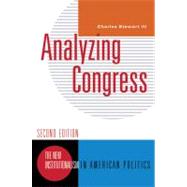
Note: Supplemental materials are not guaranteed with Rental or Used book purchases.
Purchase Benefits
What is included with this book?
| Preface | p. xv |
| An (Unusual) Introduction to the Study of Congress | p. 3 |
| The Politics of Lineland: Spatial Voting Theory in One Dimension | p. 7 |
| The Politics of Flatland: The Multidimensional Spatial Voting Model | p. 23 |
| Two Unresolved Issues: Salience and Sophistication | p. 36 |
| Spatial Voting Theory and the Study of Congress | p. 47 |
| Further Reading | p. 50 |
| Summary of Key Concepts | p. 50 |
| Problems | p. 52 |
| The Constitutional Origins of Congress | p. 58 |
| The Failure of the First Congress of the United States | p. 59 |
| What the Framers Wrought | p. 65 |
| Spatial Analysis of Constitutional Features | p. 74 |
| Further Reading | p. 88 |
| Summary of Key Concepts | p. 89 |
| Problems | p. 90 |
| The History and Development of Congress | p. 95 |
| The Experimental Era, 1789-1812 | p. 101 |
| The Democratizing System, 1820-1860 | p. 103 |
| The Civil War System, 1865-1896 | p. 111 |
| The Textbook Era, 1912-1968 | p. 117 |
| The Candidate-Centered Congress | p. 125 |
| Conclusion | p. 131 |
| Further Reading | p. 131 |
| Summary of Key Concepts | p. 132 |
| The Choices Candidates Make: Running for Congress | p. 138 |
| Strategic Choice and Political Careers | p. 140 |
| Progressive Ambition in the United States | p. 143 |
| The Costs and Benefits of Running for Office | p. 149 |
| Incumbents, Challengers, and Open Seat Candidates | p. 161 |
| Conclusion: The Engine of Ambition in Congressional Elections | p. 168 |
| Further Reading | p. 168 |
| Summary of Key Concepts | p. 169 |
| Problems | p. 170 |
| The Choices Voters Make | p. 175 |
| The Decision to Vote | p. 176 |
| Deciding Whom to Support | p. 190 |
| The Problem of Multiple Constituencies: Primaries versus the General Election | p. 195 |
| Further Reading | p. 200 |
| Summary of Key Concepts | p. 200 |
| Problems | p. 201 |
| Regulating Elections | p. 205 |
| Running for Congress: The Basics | p. 206 |
| Congressional Districting | p. 210 |
| Campaign Finance | p. 226 |
| Conclusion | p. 244 |
| Further Reading | p. 245 |
| Summary of Key Concepts | p. 245 |
| Problems | p. 247 |
| Parties and Leaders in Congress | p. 254 |
| The History of Political Parties in Congress | p. 255 |
| Parties as Organizations | p. 263 |
| On the Strength of Parties | p. 276 |
| The Benefits of Strong Parties in Congress | p. 285 |
| Conclusion | p. 289 |
| Further Reading | p. 289 |
| Summary of Key Concepts | p. 290 |
| Committees in Congress | p. 294 |
| The Committee System | p. 296 |
| House-Senate Comparisons | p. 333 |
| Theoretical Perspectives on Committees | p. 339 |
| Further Reading | p. 352 |
| Summary of Key Concepts | p. 353 |
| Problems | p. 356 |
| Doing It on the Floor: The Organization of Deliberation and What We Can Learn from It | p. 361 |
| Why a Bill Does Not Become a Law | p. 362 |
| How a Few Bills Become Law | p. 366 |
| Roll Call Votes and What They Can Tell Us | p. 397 |
| Further Reading | p. 407 |
| Summary of Key Concepts | p. 408 |
| Problems | p. 412 |
| Researching Congress | p. 417 |
| Studying Congress Generally | p. 418 |
| A Further Word about Congressional Documents | p. 420 |
| Scholarly Research on Congress | p. 422 |
| Other Electronic Sources for Studying Policy and Politics | p. 424 |
| The United States Constitution | p. 427 |
| References | p. 449 |
| Table of Contents provided by Ingram. All Rights Reserved. |
The New copy of this book will include any supplemental materials advertised. Please check the title of the book to determine if it should include any access cards, study guides, lab manuals, CDs, etc.
The Used, Rental and eBook copies of this book are not guaranteed to include any supplemental materials. Typically, only the book itself is included. This is true even if the title states it includes any access cards, study guides, lab manuals, CDs, etc.